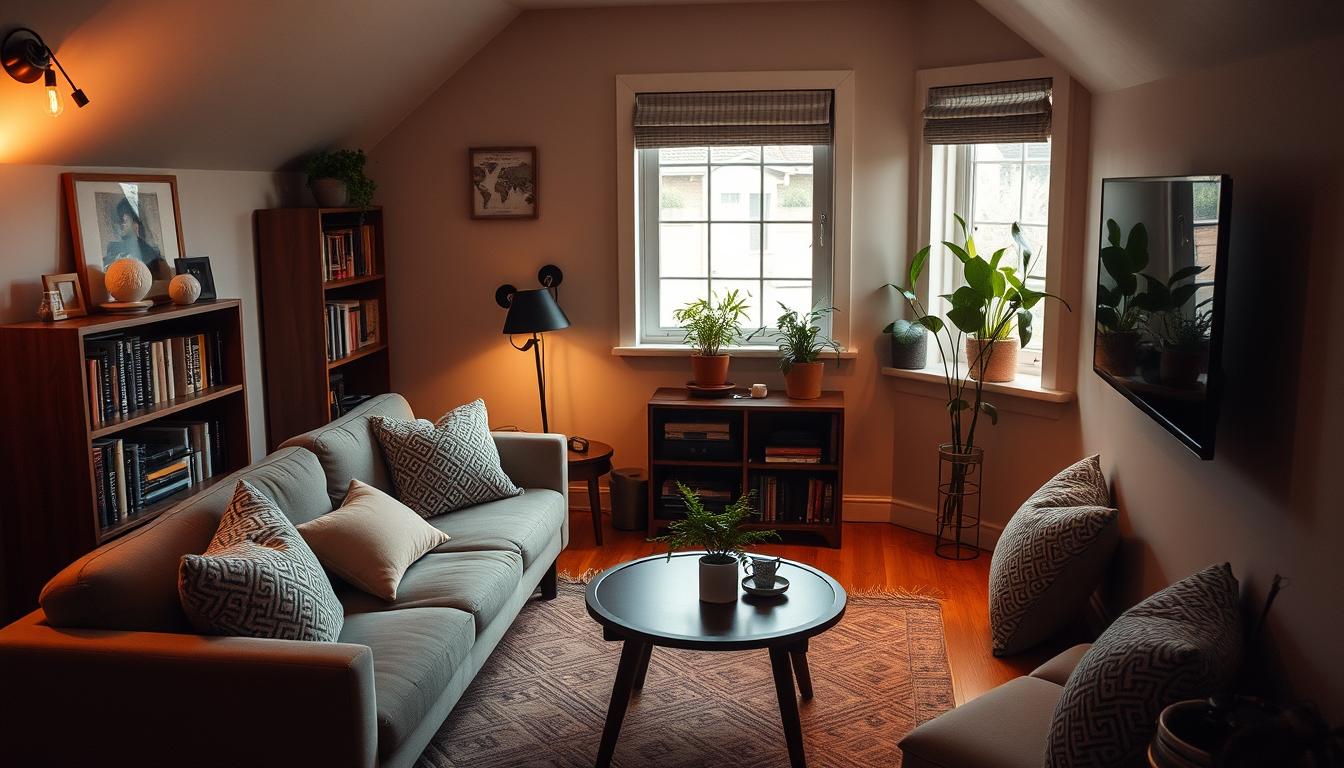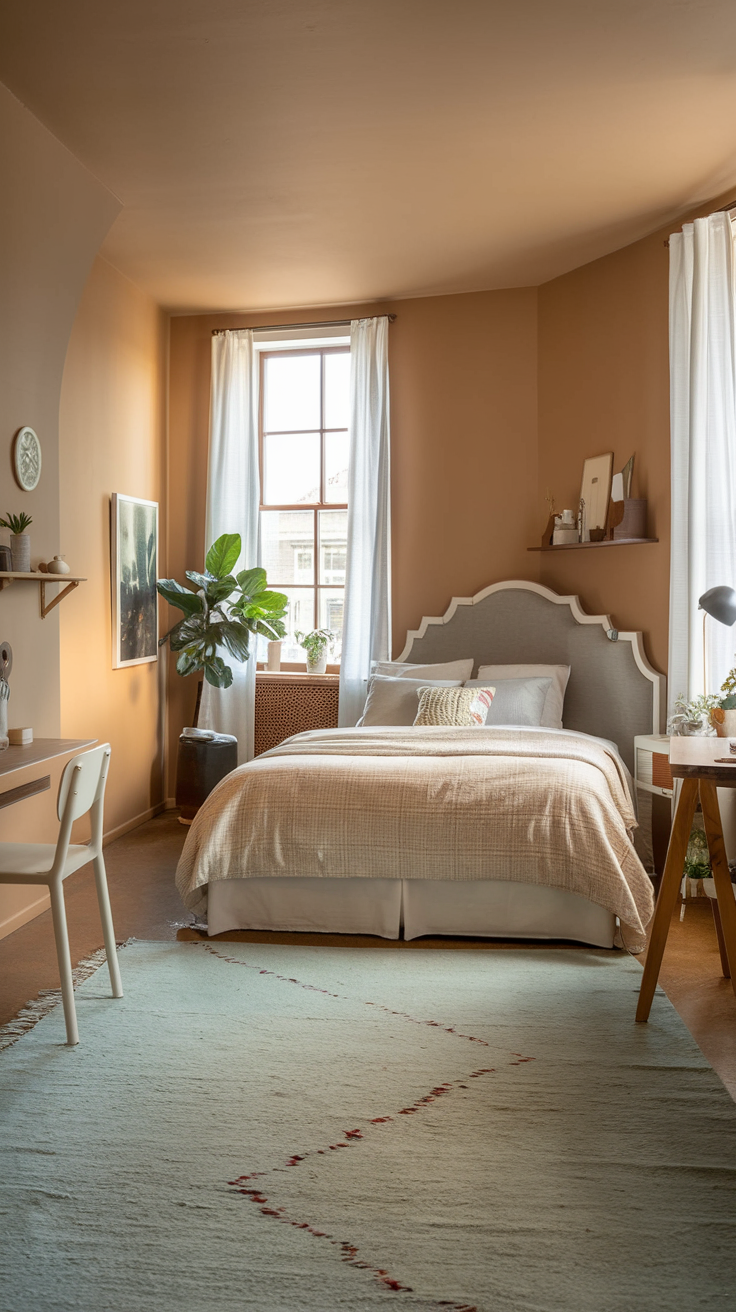I’ve learned to love the charm of small upstairs living rooms. These cozy spots, or “nooks,” can be turned into inviting places with smart design. I’ll share tips on how to make these small areas feel big and stylish.
Key Takeaways
- Embrace the challenges of small upstairs living rooms and explore creative solutions to maximize space.
- Understand the impact of architectural features and natural light on your design choices.
- Implement essential design principles to craft a cozy and inviting atmosphere.
- Strategically select and arrange furniture to enhance functionality and visual appeal.
- Utilize color, texture, and lighting to elevate the overall ambiance of the space.
Understanding the Challenges of Upstairs Living Spaces
Creating a welcoming upstairs living space is a unique challenge. Upper-level rooms often have features like attic conversions, sloped ceilings, and dormer windows. These can make layout planning tricky and affect the space’s overall feel. Also, getting enough natural light is key to making the space cozy and inviting.
Common Layout Obstacles in Upper Floor Rooms
Upper floor rooms often have awkward floor plans, slanted walls, and irregular shapes. These issues can make it hard to arrange furniture and keep the space flowing well. It’s important to think creatively about how to use the space and place furniture.
Impact of Architectural Features on Space Planning
Features like sloped ceilings and dormer windows can greatly influence how you design the space. They can guide where you put furniture, storage, and even the room’s layout. It takes a careful eye and creative thinking to work with these unique elements.
Natural Light Considerations for Upper Levels
Upper-level rooms often struggle with natural light. They might have fewer windows or get less direct sunlight. Using the right lighting and window treatments can help brighten the space and make it feel more welcoming.
Understanding the challenges of upstairs living spaces helps homeowners and designers. They can then create cozy and functional small upstairs living room ideas. These ideas make the most of these special areas.
Essential Design Principles for Small Upstairs Living Room Ideas Cozy
Creating a cozy small upstairs living room requires key design principles. Embracing minimalism, using multi-functional pieces, and ensuring a smooth visual flow are crucial. These elements help make the most of the space and create a welcoming feel.
Minimalism is a fundamental principle. Simplifying the layout and choosing clean lines can make the room feel larger. It’s important to avoid too much furniture or decor. Instead, pick items that have more than one use.
Using multi-functional furniture is another smart strategy. Look for items like ottomans with storage, coffee tables with shelves, or sofas with chaise lounges. These pieces help use space wisely and keep the room organized.
Finally, creating a smooth visual flow is essential. Arrange furniture to allow easy movement through the room. Consider windows, doors, and other features to guide the eye and balance the space.
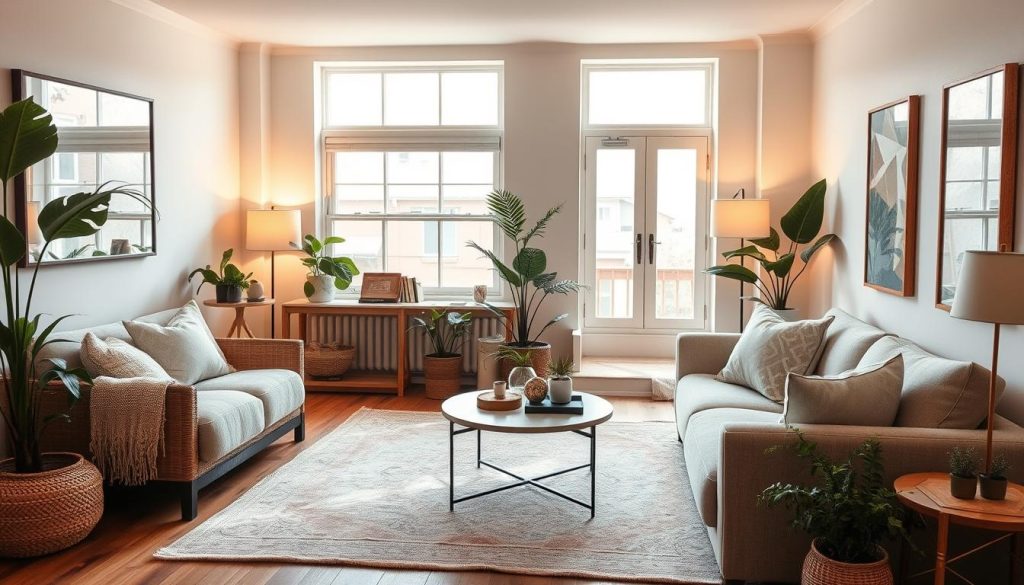
By following these design principles – minimalism, multi-functionality, and visual flow – you can turn your small upstairs living room into a cozy retreat. It will make the most of every inch of space.
Strategic Furniture Selection and Placement
Furnishing a small upstairs living room requires smart thinking. The right furniture and placement can turn it into a cozy, useful space. Let’s look at key points for choosing and placing furniture in these tight spots.
Multi-functional Furniture Solutions
In small rooms, convertible furniture and modular seating are gold. Find items that do more than one thing, like ottomans with storage or sofas that become beds. This way, you use space better and keep things tidy.
Scale-appropriate Seating Options
Choosing the right size of furniture is vital. Steer clear of big pieces that take over the room. Instead, pick smaller, fitting items like loveseats, armchairs, or swivel chairs.
Space-saving Storage Solutions
In tight spaces, smart storage solutions are essential. Look for furniture with hidden storage, like side tables with drawers or coffee tables with secret spots. Wall shelves and cabinets also help use vertical space and keep floors clear.
By picking versatile, fitting furniture and using clever storage, you can make your small living room cozy and useful. A bit of creativity and planning can turn every inch into a valuable space.
Color Schemes and Visual Space Enhancement
Choosing the right colors can greatly change how a small upstairs living room feels. Using light colors, a monochromatic palette, or accent walls can make a room feel bigger and cozier. This is especially true in tight spaces.
Light colors like pale blues, grays, or whites can make a room feel bigger. These colors reflect light, making the space feel airy and less heavy. This helps a small room look more open.
A monochromatic palette brings a calm, unified look to a room. Using different shades of one color adds depth and interest. This works well with unique features like slanted ceilings.
Using accent walls can also make a room feel larger. A contrasting color or texture on one wall draws the eye. This makes the room feel more dynamic. Just make sure the accent wall matches the room’s overall color scheme.
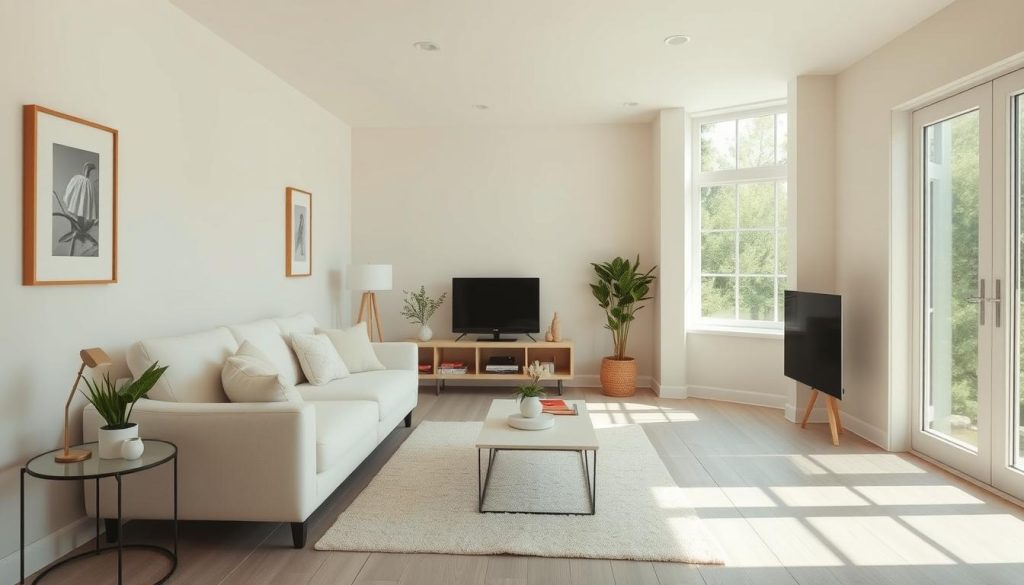
To make a small upstairs living room feel bigger, choose colors wisely. Light colors, a monochromatic palette, or accent walls can turn a small space into a cozy retreat.
Lighting Solutions for Intimate Upstairs Spaces
Creating the perfect ambiance in a small upstairs living room is a delicate task. But with the right lighting, you can turn it into a cozy retreat. We’ll look at how to use layered lighting and window treatments to brighten up your space.
Layered Lighting Techniques
For a small upstairs living room, layered lighting is key. Start with a mix of task lighting and dimmable fixtures for reading, entertaining, or relaxing. Adding skylights brings in natural light, making the room bright and airy.
Window Treatment Strategies
It’s important to control the natural light in your upstairs room. Choose window treatments like sheer curtains or roman shades that can be adjusted. This lets you change the mood of the room throughout the day. Pair these with your layered lighting for a cozy atmosphere.
Ambient Lighting Options
For the final touch, add ambient lighting that sets the mood. Wall sconces, floor lamps, and table lamps create a warm glow. This is perfect for relaxing or hosting guests in your cozy upstairs room.
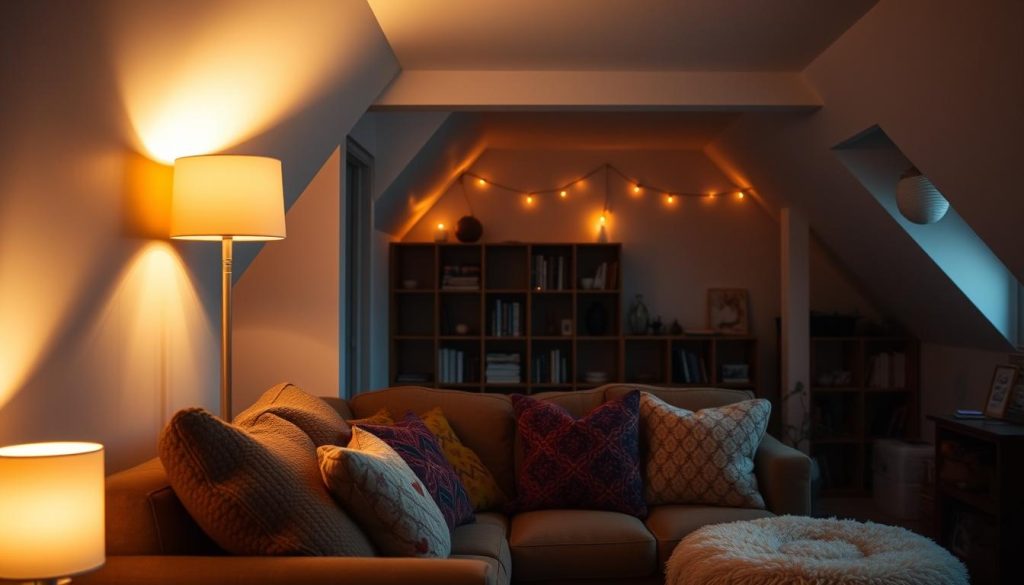
By choosing the right lighting and integrating it well, you can make your small upstairs room cozy and inviting. It will become a space you’ll love spending time in.
Maximizing Vertical Space with Smart Storage
In a small upstairs living room, every inch of space is precious. Instead of letting clutter take over, why not look up? Using vertical space with smart storage can change the game for a cozy, organized living area.
Wall-mounted shelves are a great way to make the most of vertical space. They let you display items, store books, or hide small things without using up floor space. For a unified look, try floor-to-ceiling bookcases that fit right into the room’s design.
Built-in storage is another smart choice for a more integrated look. Custom cabinets and shelves that fit flush with the walls make the room look clean and organized. They can be made to fit your exact needs, making sure every spot is used well.
“Vertical storage is a game-changer in small spaces – it allows you to maximize your square footage without cluttering the floor.”
When picking storage, think about size and fit. Big, bulky items can make a small room feel cramped. Choose slim, sleek designs that match the room’s size. This way, you can make a cozy, clutter-free space that’s both welcoming and useful.
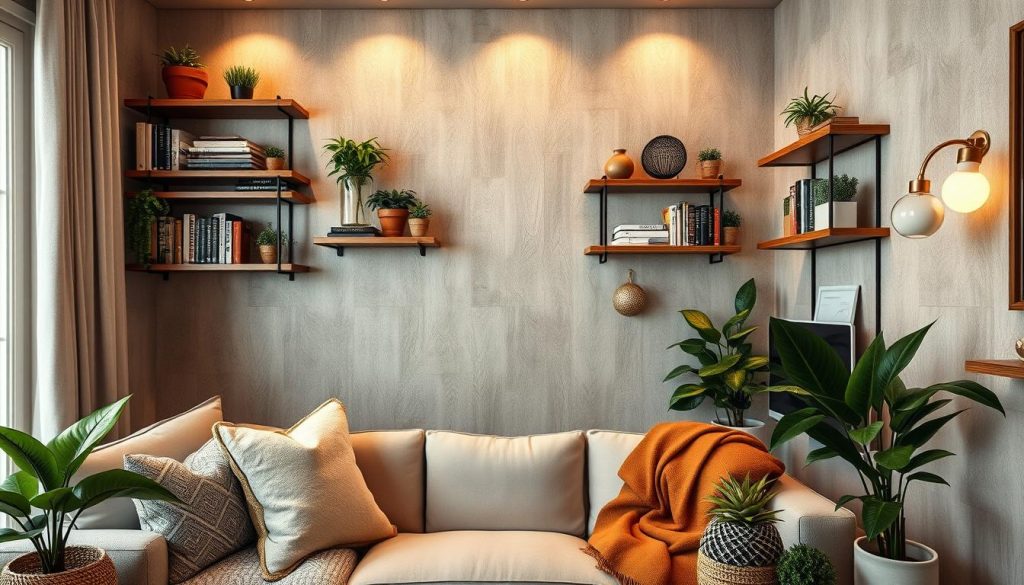
The secret to great vertical storage in a small room is to be creative and choose pieces that fit well. With some planning and the right storage, you can turn your cozy spot into a stylish, functional living area.
Texture and Pattern Integration for Coziness
To make an upstairs living room cozy, you need more than just furniture. Adding tactile fabrics, plush rugs, and throw pillows can really make a difference. Mixing textures and patterns creates a space that’s both beautiful and comforting.
Textile Selection Guide
Choose textiles that feel good to touch. Velvet, chenille, and wool are great for furniture and blankets. Add patterned fabrics like jacquards or prints for interest. Make sure the patterns fit well in the room.
Layering Different Materials
Layering materials adds depth to your living room. Start with a soft rug, then add throw pillows with different feels. A throw blanket on the sofa adds warmth. Mixing materials makes your space look and feel rich.
Creating Visual Interest Without Clutter
It’s easy to overdo it with decorations. But, it’s key to keep things balanced. Place a few special items, like a vase or basket, to add depth. Aim for a cozy feel, not a messy one.
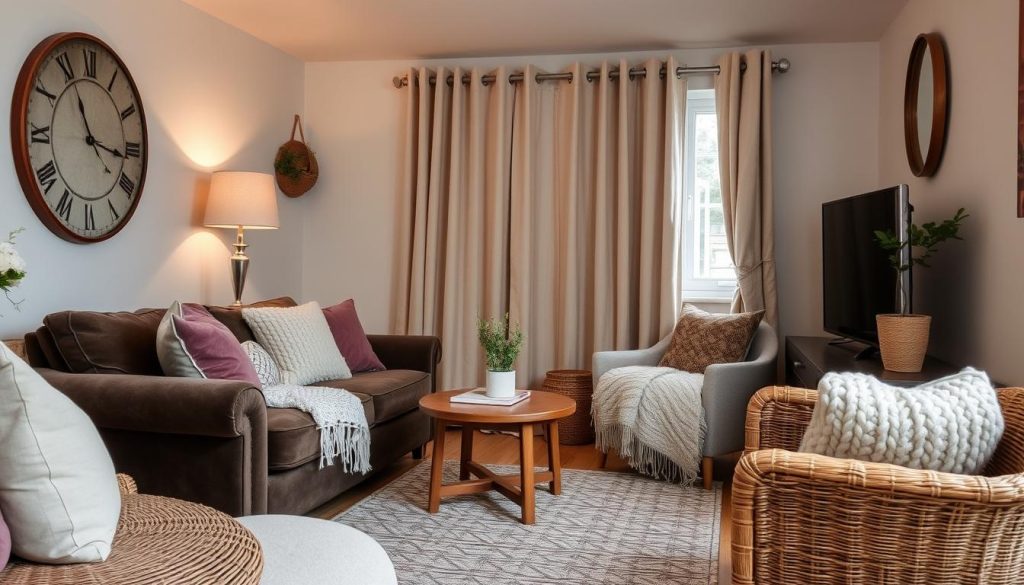
“Texture is the unsung hero of interior design. It’s the secret ingredient that makes a space feel warm, welcoming, and lived-in.”
Incorporating Personal Style While Maintaining Functionality
I believe your living space should show off your personality. Small upstairs living rooms offer a fun challenge to balance style and function. Let’s see how to add your personal touch while keeping your space cozy and practical.
One great way to show your style is with gallery walls. Hang a mix of artwork, photos, or special items to make a striking focal point. This lets you create a display that reflects your interests and taste.
Adding statement pieces is another smart move. A bold chair, unique light, or eye-catching coffee table can make your space stand out. These pieces can turn your room into a reflection of your personality.
Also, feel free to customize your space to fit your needs. You can add built-in shelves or special window treatments. Tailoring your design to your life makes your room a cozy haven.
“Your home should tell the story of who you are, and be a collection of what you love.”
– Nate Berkus
To blend personal style with function in a small room, find a balance. By adding your unique touches, you can make a small space feel warm and welcoming. It becomes a place that truly feels like home.
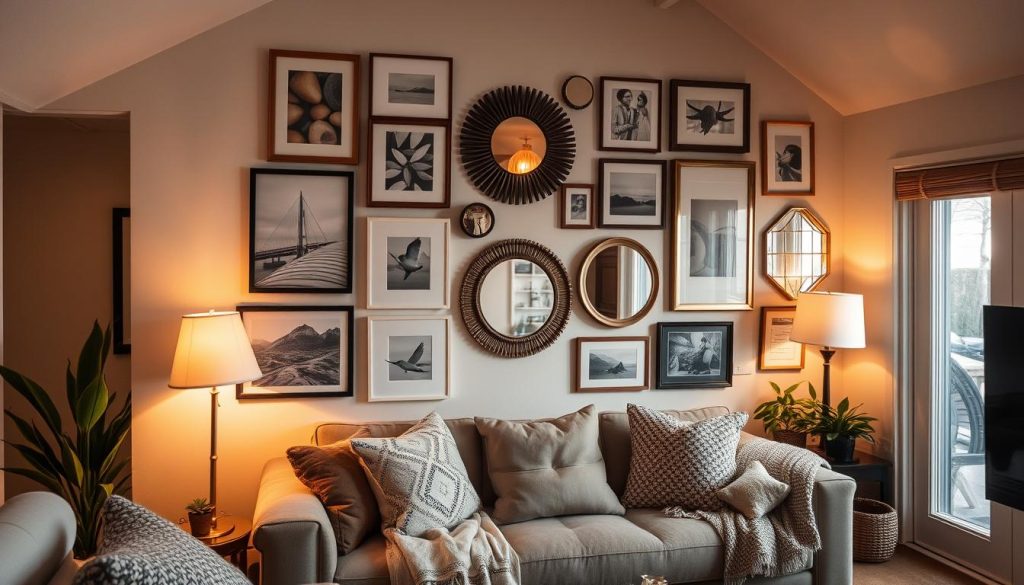
Conclusion
Creating a welcoming and useful small upstairs living room needs careful planning. It’s about understanding the special challenges of upper rooms. Then, use key design rules and pick the right furniture and decor.
By embracing your small upstairs room’s charm, you can make the most of it. You can turn it into a cozy spot for reading, watching TV, or working. The tips in this article will help you.
The trick to making the most of small spaces is to mix function and style. Add different textures, smart lighting, and clever storage. This way, you’ll make a space that feels like your own, full of comfort and inspiration.

